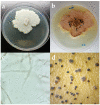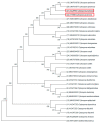First Report of Olive Branch Dieback in Croatia Caused by Cytospora pruinosa Défago
- PMID: 37512852
- PMCID: PMC10384268
- DOI: 10.3390/microorganisms11071679
First Report of Olive Branch Dieback in Croatia Caused by Cytospora pruinosa Défago
Abstract
Olive (Olea europaea L.) is a very important crop grown in the Mediterranean part of Croatia. Olive branch and fruit dieback symptoms were observed in two olive orchards in Istria, Croatia. The samples from symptomatic trees were collected and brought to the laboratory for analysis. Based on their morphological characterization, isolated fungi were identified as Cytospora sp. Two representative isolates (one per orchard) were taken for molecular analysis, and based on DNA sequence data of the ITS and TUB gene regions, and phylogenetic analysis of the sequences, the isolates were identified as Cytospora pruinosa Défago. To determine pathogenicity, pathogenicity tests were conducted on detached olive branches and two-year-old olive trees in the greenhouse. This is the first report of C. pruinosa causing olive branch and fruit dieback in Croatia.
Keywords: Cytospora sp.; Olea europaea L.; canker; fungal disease.
Conflict of interest statement
The authors declare no conflict of interest.
Figures




References
-
- Rapoport H.F., Fabbri A., Sebastiani L. Olive Biology. The Olive Tree Genome. Springer; Cham, Switzerland: 2016. pp. 13–25.
-
- Fraga H., Moriondo M., Leolini L., Santos J.A. Mediterranean olive orchards under climate change: A review of future impacts and adaptation strategies. Agronomy. 2021;11:56. doi: 10.3390/agronomy11010056. - DOI
-
- Mafrica R., Piscopo A., De Bruno A., Poiana M. Effects of climate on fruit growth and development on olive oil quality in cultivar Carolea. Agriculture. 2021;11:147. doi: 10.3390/agriculture11020147. - DOI
Grants and funding
LinkOut - more resources
Full Text Sources

